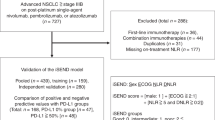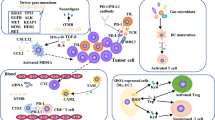Abstract
Background
Anti-programmed death-1 (PD-1) antibody changed the treatment of non-small cell lung cancer (NSCLC), however, reliable predictive markers were lacking. We aimed to explore factors associated with response and survival, and develop predictive models.
Methods
This multicenter retrospective study included a training cohort (n = 92) and validation cohort (n = 111) with NSCLC patients received anti-PD-1 antibody monotherapy in eight Chinese hospitals, and a control cohort (n = 124) with NSCLC patients received chemotherapy. Logistic and Cox models were used to identify factors associated with response and survival respectively. Nomograms were developed based on significant factors, and evaluated by Concordance-index (C-index), area under the curve (AUC) and calibration curve.
Result
In training cohort, smoking history (P = 0.027) and higher absolute lymphocyte count (P = 0.038) were associated with response. Female (P < 0.001), age ≥ 65 years (P = 0.004) and higher lactate dehydrogenase (LDH, P < 0.001) were associated with shorter progression-free survival (PFS). Higher LDH (P < 0.001) and derived neutrophil-to-lymphocyte ratio (P = 0.035) were associated with poorer overall survival (OS). While these factors were nonsignificant in chemotherapy cohort. Three nomograms to predict response at 6-week after treatment, PFS and OS at 6-, 12- and 18-months were developed, and validated in validation cohort. The C-indices of each nomogram in both cohorts were as follow (training vs validation): 0.706 vs 0.701; 0.728 vs 0.701; 0.741 vs 0.709; respectively. AUC showed a good discriminative ability. Calibration curves demonstrated a consistence between actual results and predictions.
Conclusion
We developed predictive nomograms based on easily available factors to help clinicians early assess response and prognosis for NSCLC patients received anti-PD-1 antibody.







Similar content being viewed by others
Data availability
All data is collected from medical record and is available.
Code availability
Not applicable.
Abbreviations
- AEC:
-
Absolute eosinophil count
- ALC:
-
Absolute lymphocyte count
- ALK:
-
Anaplastic lymphoma kinase
- AMC:
-
Absolute monocyte count
- ANC:
-
Absolute neutrophil count
- AUC:
-
Area under the curve
- C-index:
-
Concordance index
- CRP:
-
C-reactive protein
- DDR:
-
DNA damage repair
- dNLR:
-
Derived neutrophil-to-lymphocyte ratio
- ECOG PS:
-
Eastern Cooperative Oncology Group performance status
- EGFR:
-
Epidermal growth factor receptor
- IDO:
-
Indoleamine2,3-dioxygenase
- IQR:
-
Interquartile ranges
- KRAS:
-
Kirsten rat sarcoma
- LDH:
-
Lactate dehydrogenase
- mOS:
-
Median overall survival
- mPFS:
-
Median progression-free survival
- MSI:
-
Microsatellite instability
- NLR:
-
Neutrophil-to-lymphocyte ratio
- NSCLC:
-
Non-small cell lung cancer
- ORR:
-
Objective response rate
- OS:
-
Overall survival
- PD:
-
Progressive disease
- PD-1:
-
Programmed death-1
- PD-L1:
-
Programmed death-1-ligand 1
- PFS:
-
Progression-free survival
- PNI:
-
Prognostic nutritional index
- PR:
-
Partial response
- SD:
-
Stable disease
- TILs:
-
Tumor infiltrating lymphocytes
- TMB:
-
Tumor mutation burden
- WBC:
-
White blood cell count
References
Chen W, Zheng R, Baade PD, Zhang S, Zeng H, Bray F, Jemal A, Yu XQ, He J (2016) Cancer statistics in China, 2015. CA Cancer J Clin 66:115–132. https://doi.org/10.3322/caac.21338
Travis WD, Brambilla E, Nicholson AG et al (2015) The 2015 World Health Organization Classification of Lung Tumors: impact of genetic, clinical and radiologic advances since the 2004 classification. J Thorac Oncol 10:1243–1260. https://doi.org/10.1097/JTO.0000000000000630
Brahmer J, Reckamp KL, Baas P et al (2015) Nivolumab versus docetaxel in advanced squamous-cell non-small-cell lung cancer. N Engl J Med 373:123–135. https://doi.org/10.1056/NEJMoa1504627
Borghaei H, Paz-Ares L, Horn L et al (2015) Nivolumab versus docetaxel in advanced non-squamous non-small-cell lung cancer. N Engl J Med 373:1627–1639. https://doi.org/10.1056/NEJMoa1507643
Herbst RS, Baas P, Kim DW et al (2016) Pembrolizumab versus docetaxel for previously treated, PD-L1-positive, advanced non-small-cell lung cancer (KEYNOTE-010): a randomized controlled trial. Lancet 387:1540–1550. https://doi.org/10.1016/S0140-6736(15)01281-7
Reck M, Rodriguez-Abreu D, Robinson AG et al (2016) Pembrolizumab versus chemotherapy for PD-L1–positive non–small-cell lung cancer. N Engl J Med 375:1823–1833. https://doi.org/10.1056/NEJMoa1606774
Hoy SM (2019) Sintilimab: first global approval. Drug 79:341–346. https://doi.org/10.1007/s40265-019-1066-z
Keam SJ (2019) Toripalimab: first global approval. Drug 79:573–578. https://doi.org/10.1007/s40265-019-01076-2
Markham A, Keam SJ (2019) Camrelizumab: first global approval. Drug 79:1355–1361. https://doi.org/10.1007/s40265-019-01167-0
Lee A, Keam SJ (2020) Tislelizumab: first approval. Drug 80:617–624. https://doi.org/10.1007/s40265-020-01286-z
Rizvi NA, Hellmann MD, Snyder A et al (2015) Cancer immunology. Mutational landscape determines sensitivity to PD-1 blockade in non–small cell lung cancer. Science 348:124–128. https://doi.org/10.1126/science.aaa1348
Dudley JC, Lin MT, Le DT, Eshleman JR (2016) Microsatellite instability as a biomarker for PD-1 Blockade. Clin Cancer Res 22:813–820. https://doi.org/10.1158/1078-0432.CCR-15-1678
Conway JR, Kofman E, Mo SS, Elmarakeby H, Van Allen E (2018) Genomics of response to immune checkpoint therapies for cancer: implications for precision medicine. Genome Med 10:93. https://doi.org/10.1186/s13073-018-0605-7
Botticelli A, Salati M, Di Pietro FR et al (2019) A nomogram to prepare survival in non-small cell lung cancer patients with nivolumab. J Transl Med 17:99. https://doi.org/10.1186/s12967-019-1847-x
Park W, Kwon D, Saravia D et al (2018) Developing a predictive model for clinical outcomes of advanced non-small cell lung cancer patients treated with nivolumab. Clin Lung Cancer 19(280):288. https://doi.org/10.1016/j.cllc.2017.12.007
Mo J, Hu X, Gu L, Chen B, Khadaroo PA, Shen Z, Dong L, Lv Y, Chitumba MN, Liu J (2020) Smokers or non-Smokers: who benefits more from immune checkpoint inhibitors in the treatment of malignancies? An up-to-date meta-analysis. World J Surg Oncol 18:15. https://doi.org/10.1186/s12957-020-1792-4
Tanizaki J, Haratani K, Hayashi H et al (2018) Peripheral blood biomarkers associated with clinical outcome in non-small cell lung cancer patients treated with nivolumab. J Thorac Oncol 13:97–105. https://doi.org/10.1016/j.jtho.2017.10.030
Zhang ZB, Li Y, Yan X, Song Q, Wang GQ, Hu Y, Jiao SC, Wang JL (2019) Pretreatment lactate dehydrogenase may predict outcome of advanced non small-cell lung cancer patients treated with immune checkpoint inhibitors: a meta-analysis. Cancer Med 8:1467–1473. https://doi.org/10.1002/cam4.2024
Mezquita L, Auclin E, Ferrara R et al (2018) Association of the lung immune prognostic index with immune checkpoint inhibitor outcomes in patients with advanced non-small cell lung cancer. JAMA Oncol 4:351–357. https://doi.org/10.1001/jamaoncol.2017.4771
Shoji F, Takeoka H, Kozuma Y, Toyokawa G, Yamazaki K, Ichiki M, Takeo S (2019) Pretreatment prognostic nutritional index as will be a biomarker in non-small cell lung cancer patients treated with immune checkpoint inhibitors. Lung Cancer 136:45–51. https://doi.org/10.1016/j.lungcan.2019.08.006
Wang YZ, Li J, Xia Y et al (2013) Prognostic nomogram for intrahepatic cholangiocarcinoma after partial hepatectomy. J Clin Oncol 31:1188–1195. https://doi.org/10.1200/JCO.2012.41.5984
Goldstraw P, Crowley J, Chansky K, Giroux DJ, Groome PA, Rami-Porta R, Postmus PE, Rusch V, Sobin L, International Association for the Study of Lung Cancer International Staging Committee (2007) The IASLC Lung Cancer Staging Project: proposals for the revision of the TNM stage groupings in the Forthcoming (Seventh) Edition of the TNM Classification of Malignant Tumours. J Thorac Oncol 2:706–714. https://doi.org/10.1097/JTO.0b013e31812f3c1a
Eisenhauer EA, Therasse P, Bogaerts J et al (2009) New response evaluation criteria in solid tumours: revised RECIST guideline (version 1.1). Eur J Cancer 45:228–247. https://doi.org/10.1016/j.ejca.2008.10.026
Zhang LY, Sun LT, Yu JR et al (2019) Comparison of immune checkpoint inhibitors between older and younger patients with advanced or metastatic lung cancer: a systematic review and meta-analysis. Biomed Res Int 2019:9853701. https://doi.org/10.1155/2019/9853701
Nishijima TF, Muss HB, Shachar SS, Moschos SJ (2016) Comparison of efficacy of immune checkpoint inhibitors (ICIs) between younger and older patients: a systematic review and meta-analysis. Cancer Treat Rev 45:30–37. https://doi.org/10.1016/j.ctrv.2016.02.006
Corbaux P, Maillet D, Boespflug A et al (2019) Older and younger patients treated with immune checkpoint inhibitors have similar outcomes in real-life setting. Eur J Cancer 121:192–201. https://doi.org/10.1016/j.ejca.2019.08.027
Wang S, Cowley LA, Liu XS (2019) Sex differences in cancer immunotherapy efficacy, biomarkers, and therapeutic strategy. Molecules 24:3214. https://doi.org/10.3390/molecules24183214
Alexandrov LB, Nik-Zainal S, Wedge DC et al (2013) Signatures of mutational processes in human cancer. Nature 500:415–421. https://doi.org/10.1038/nature12477
Kerdidani D, Magkouta S, Chouvardas P et al (2018) Cigarette smoke-induced emphysema exhausts early cytotoxic CD8(+) T cell responses against nascent lung cancer cells. J Immunol 201:1558–1569. https://doi.org/10.4049/jimmunol.1700700
Herbst RS, Soria JC, Kowanetz M et al (2014) Predictive correlates of response to the anti-PD-L1 antibody MPDL3280A in cancer patients. Nature 515:563–567. https://doi.org/10.1038/nature14011
Brahmer JR, Drake CG, Wollner I et al (2010) Phase I study of single-agent, anti-programmed death 1 (MDX-1106) in refractory solid tumors: safety, clinical activity, pharmacodynamics, and immunologic correlates. J Clin Oncol 28:3167–3175. https://doi.org/10.1200/JCO.2009.26.7609
Miao P, Sheng SL, Sun XG, Liu JJ, Huang G (2013) Lactate dehydrogenase A in Cancer: a promising target for diagnosis and therapy. IUBMB Life 65:904–910. https://doi.org/10.1002/iub.1216
Diakos CI, Charles KA, McMillan DC, Clarke SJ (2014) Cancer-related inflammation and treatment effectiveness. Lancet Oncol 15:e493–503. https://doi.org/10.1016/S1470-2045(14)70263-3
Proctor MJ, McMillan DC, Morrison DS, Fletcher CD, Horgan PG, Clarke SJ (2012) A derived neutrophil to lymphocyte ratio predicts survival in patients with cancer. Br J Cancer 107:695–699. https://doi.org/10.1038/bjc.2012.292
Acknowledgements
We gratefully acknowledge Shaojun Xin, Fei Yu and Jiangnan Chen for their data collection. And we also would like to acknowledge Yanzhong Wang for proof reading the article.
Funding
Project supported by the National Natural Science Foundation of China (Grant No. 81972012). None of the funders had any role in the study design and the collection, analysis, and interpretation of data or in the writing of the article and the decision to submit it for publication. The researchers confirm their independence from funders and sponsors.
Author information
Authors and Affiliations
Contributions
JZ, XX and HL conceived the idea, developed the theory, and JZ interpret the results. SY, LS, LY, LL and LC carried out the data collection. And JZ also supervised the data collection. YX conducted the statistical analysis. SY wrote the manuscript with support from YX. All authors discussed the results and contributed to the final manuscript.
Corresponding author
Ethics declarations
Conflict of interest
None of the authors have any disclosure to make.
Ethics approval
This work was carried out in human with approval from the Institutional Review Board. For this type of study, formal consent is not required. Institutional Review Board, therefore, granted waiver for this retrospective study.
Consent to participate
All authors consent to participate this study.
Consent for publication
All authors consent to publish this study.
Additional information
Publisher's Note
Springer Nature remains neutral with regard to jurisdictional claims in published maps and institutional affiliations.
Electronic supplementary material
Below is the link to the electronic supplementary material.
Rights and permissions
About this article
Cite this article
Yuan, S., Xia, Y., Shen, L. et al. Development of nomograms to predict therapeutic response and prognosis of non-small cell lung cancer patients treated with anti-PD-1 antibody. Cancer Immunol Immunother 70, 533–546 (2021). https://doi.org/10.1007/s00262-020-02710-9
Received:
Accepted:
Published:
Issue Date:
DOI: https://doi.org/10.1007/s00262-020-02710-9




